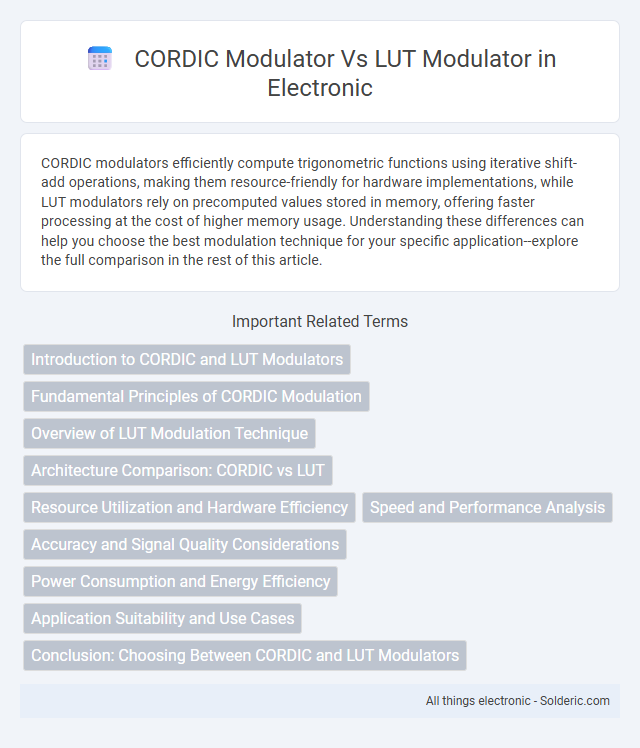CORDIC modulators efficiently compute trigonometric functions using iterative shift-add operations, making them resource-friendly for hardware implementations, while LUT modulators rely on precomputed values stored in memory, offering faster processing at the cost of higher memory usage. Understanding these differences can help you choose the best modulation technique for your specific application--explore the full comparison in the rest of this article.
Comparison Table
| Feature | CORDIC Modulator | LUT Modulator |
|---|---|---|
| Principle | Iterative vector rotation algorithm | Precomputed values stored in lookup tables |
| Area | Low area overhead, uses simple adders and shifters | Potentially large memory footprint depending on resolution |
| Speed | Moderate, depends on iteration count | High throughput with single-cycle access |
| Power Consumption | Lower due to lightweight operations | Higher due to memory access energy |
| Flexibility | Highly flexible, supports dynamic scaling and phase adjustments | Less flexible; fixed by LUT size and contents |
| Accuracy | Adjustable via iteration depth | Fixed by LUT resolution |
| Complexity | Algorithmic complexity requires control logic | Simpler control, increased memory complexity |
| Application Suitability | Suitable for area and power-sensitive designs | Ideal for high-speed applications with adequate memory |
Introduction to CORDIC and LUT Modulators
CORDIC modulators utilize the COordinate Rotation DIgital Computer algorithm to perform trigonometric computations through iterative shift-add operations, enabling efficient real-time signal phase and amplitude modulation without requiring multiplication. LUT modulators, or Look-Up Table modulators, rely on precomputed values stored in memory to directly map input indices to modulation coefficients, offering rapid output generation at the expense of increased memory usage. Both approaches serve critical roles in digital communication systems, with CORDIC focusing on computational efficiency and LUT emphasizing speed and simplicity in waveform generation.
Fundamental Principles of CORDIC Modulation
CORDIC modulators compute trigonometric functions using iterative shift-and-add operations, enabling efficient angle rotation without multipliers, which is essential for real-time signal processing in digital communication systems. Unlike LUT modulators that rely on precomputed values stored in memory, CORDIC dynamically generates sine and cosine outputs based on input angles, reducing memory usage and improving scalability. Your system can benefit from CORDIC modulation's low computational complexity and adaptability, especially in hardware-constrained environments.
Overview of LUT Modulation Technique
The LUT modulation technique uses precomputed tables to store waveform values, enabling rapid signal generation with low computational complexity and high precision. This method is advantageous in applications where memory availability allows fast access to stored data, reducing latency compared to algorithmic approaches. Your system benefits from LUT modulators particularly in scenarios requiring stable and repeatable output waveforms with minimal real-time calculation overhead.
Architecture Comparison: CORDIC vs LUT
CORDIC modulators feature iterative shift-and-add architecture, optimizing hardware efficiency and reducing memory usage, while LUT modulators rely on precomputed tables enabling faster computation at the cost of larger memory requirements. CORDIC's sequential processing suits resource-constrained environments, whereas LUT's parallel access supports high-speed applications with abundant memory. Your choice depends on balancing speed, hardware complexity, and memory availability in the target system.
Resource Utilization and Hardware Efficiency
CORDIC modulator offers lower resource utilization by employing iterative shift-add operations, minimizing the need for large memory blocks compared to LUT modulators, which rely heavily on stored waveform tables resulting in higher memory consumption. Your design benefits from CORDIC's hardware efficiency, especially in FPGA and ASIC implementations, as it reduces the demand for multipliers and large ROMs, leading to smaller logic footprint and energy savings. LUT modulators provide faster output at the expense of increased area and power, making CORDIC modulators preferable for resource-constrained systems seeking optimized hardware utilization.
Speed and Performance Analysis
CORDIC modulators offer high-speed arithmetic computations with low hardware resource usage, making them efficient for real-time signal processing applications. LUT modulators provide faster modulation through precomputed values, but their speed and performance can be limited by memory size and access delay, especially in high-resolution or complex modulation schemes. Overall, CORDIC modulators excel in scenarios requiring adaptive computations, while LUT modulators are preferable for fixed, repetitive modulation tasks due to their rapid lookup capabilities.
Accuracy and Signal Quality Considerations
CORDIC modulators provide high accuracy by performing iterative rotations with minimal hardware, which reduces quantization errors and improves signal fidelity. LUT modulators rely on precomputed values stored in memory, offering faster outputs but potentially lower signal quality due to interpolation errors and limited resolution. Your choice between CORDIC and LUT modulators impacts the precision of phase and amplitude generation, directly affecting overall signal quality in communication systems.
Power Consumption and Energy Efficiency
CORDIC modulators generally consume less power than LUT modulators because they use iterative shift-add operations instead of large memory blocks, making them more energy-efficient for real-time signal processing. LUT modulators, relying on precomputed values stored in memory, tend to have higher power consumption due to frequent memory access and larger silicon area requirements. Optimizing your design with a CORDIC modulator can significantly improve energy efficiency, especially in applications demanding low power and high-speed modulation.
Application Suitability and Use Cases
CORDIC modulators excel in resource-constrained environments where hardware efficiency and low power consumption are critical, making them suitable for real-time signal processing in embedded systems and FPGA implementations. LUT modulators provide rapid waveform generation and high precision, ideal for applications requiring fast lookup and modulation in software-defined radios and baseband processing. Your choice between CORDIC and LUT modulators depends on specific application needs such as speed, accuracy, and hardware limitations.
Conclusion: Choosing Between CORDIC and LUT Modulators
CORDIC modulators offer efficient hardware implementation with low memory usage by computing trigonometric functions iteratively, making them ideal for resource-constrained environments. LUT modulators provide faster outputs by retrieving precomputed values from memory, suitable for applications requiring high-speed processing and where memory resources are ample. Selecting between CORDIC and LUT modulators depends on balancing hardware complexity, memory availability, and processing speed requirements specific to the target system.
CORDIC modulator vs LUT modulator Infographic

 solderic.com
solderic.com